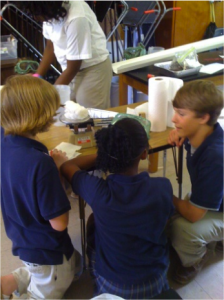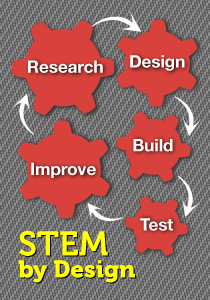Effective Student STEM Teams
Anne Jolly began her career as a lab scientist, caught the science teaching bug and became an award-winning middle grades science teacher. Today she works on an NSF-supported team, developing standards-based STEM curricula for grades 6-8. Anne’s blog appears weekly at MiddleWeb, and one important focus is to engage readers in chats around STEM subjects. See all of Anne’s posts here.
In this post let’s begin tackling the STEM challenge by looking at student teaming. I know from many years of working with and among teachers that putting students into teams for active learning is not something everyone looks forward to — and that it can be even more worrisome for teachers just starting out. I have some starter ideas and a draft 7-step guide you can download.
But first: Just what is the STEM challenge?
You’ve heard on all fronts that we need to engage our students in STEM lessons because that’s the way to prepare them for the 21st century workforce. So what, exactly, will this workforce need to do? Of course, we don’t know the full answer to that, but the National Academy of Engineering has identified Fourteen Grand Challenges we face that will affect our health, security and enjoyment of living, and perhaps human survival.
Challenges our students face
Behold the 14 challenges for which our students need to be prepared to invent solutions:
|
|
I’m looking at some of those challenges and wondering, “What does that one mean?” Or, “Why is that so important?” If you have the same questions, check out this report that explains the What and Why. It’s actually readable and interesting.
Challenges teachers face
To find solutions for these challenges, citizens from many professions will be working together. Guess who’s responsible for preparing the foundation for these future citizens to be able to work in teams, identify problems, research and use information, make decisions, create solutions, test those solutions, and redesign until they have solved the problem?
If you’re a K-12 educator, look in the mirror.
So, how do you feel about this? Do you feel prepared to help your students learn to tackle STEM challenges and design solutions? If not, then cheer up. I doubt if any of us do at this point. We’re actually at the beginning of a learning journey. And. . .we may finally be on the verge of helping our students see real-world value of the content we teach. Together, let’s tackle the daunting challenge of learning/designing/teaching STEM curriculum for our middle schoolers one step at a time.
As an aside – I think the ideal professional learning for teachers involves teams of teachers in working together to design, implement, and evaluate STEM curriculum. Maybe we’ll have time down the road to look at teacher teaming. In the meantime, you might want to take a look at this book for some “how tos” on setting up and conducting successful teacher teams in your school. If you work together, you’ll make faster inroads and the material will seem more authentic to the students.
Facilitate productive student teams

Keep the teams small. Don’t put more than four students in a team if you can help it.
Give individual teams time to set ground rules for how they will work together. Start by asking members in each team to share behaviors they value in other team members. Then ask a team member to write down the behaviors that team values to make a set of team rules. They might set rules like these: All team members will listen to one another, respect other team members, share responsibilities, do his or her job well, have a good attitude, and so forth. Teams can add new rules as needed to make their work productive.
Give students guides for assessing their teamwork from time to time. Self-assessments can help students understand how team members might ideally work together.
 7 Steps to Successful Student STEM Teaming
7 Steps to Successful Student STEM Teaming
I don’t pretend to be the know-all and be-all of student teaming, but I have started putting together a guide that I hope will be useful in establishing productive student teams for STEM projects. It’s still a draft. I’ve identified 7 steps… maybe there are 10!
- Step 1: Organize and plan for teamwork
- Step 2: Introduce a teamwork rationale (Why are we working in teams?)
- Step 3: Establish a purpose for the teams’ work (What is our purpose?)
- Step 4: Establish teamwork procedures (How will we do the work?)
- Step 5: Develop teamwork skills
- Step 6: Monitor teamwork
- Step 7: Check teamwork progress
Feel free to download my draft guide here (in PDF form) and try out some of the ideas. As you’ll see, I’ve added tips and discussion under each step. There are also several tools (handouts) at the end: a team skills inventory (to be done together); an individual team member self-evaluation; a full-team evaluation; and finally a Teamwork Skills Assessment sheet that teachers can use when they’re observing how well a team is working together.
Add ideas and notes of your own in the margins of my draft. Share freely on one condition: You share here first, in our comments section!































While I am not a science teacher, Anne, I see the applicability of your plan for all subject areas. Your steps for developing effective team processes are something I will use with my math students as we design and carry out projects this year. Teaching a small group of students with IEP’s is often challenging when it comes to group processes. Your 7 step plan will help me guide them as we learn how and why working in teams is beneficial to us all. The step I find I struggle with the most is the last step. It always seems after we’ve done our work, I am too harried to find time for the debriefing process. I would be interested in how you manage your time to fit this in! How long do you allot for debriefing? is this done as a large group or individually? Do you have students journal about it? I am looking for ideas! Thanks!
Here are a couple of ideas I’ve learned, Cossondra. If I wait until the very end to debrief I do sometimes run out of time. That means that the debriefing takes place the next day, and by that time it’s lost it’s punch. So . . .
1. Try debriefing as you go along. About every 10 minutes stop the teams and ask them what’s happened so far, what they are trying to accomplish, and whether the direction they’re going is taking them there. In other words, think of the debriefing questions you would need to ask to bring understanding, learning, and closure to the lesson . . . and see if you can intersperse them throughout the lesson.
2. Begin the activity you want to debrief toward the middle or end of the previous day’s class, as long as there’s a natural break somewhere and the kids won’t have to start from scratch the next day. That may free up some time toward the end of the class for debriefing.
3. If you have to debrief the following day, give the students the materials they worked with the day before to help them get back into the mindset the need. Use some cognitive thinking strategies to bring them back to where they were the day before.
4. Or, their homework might be to summarize what they learned, etc. Then that could lead into a debriefing discussion the next day. (Start with letting the teams debrief among themselves, then have a member from each team share with the class. That way everyone is involved in the debriefing process.)
Looking forward to checking out your student teaming guide, Anne. As a guy who has been teaching forever — including 7 years in the middle grades science classroom — I STILL don’t feel super comfortable with the group work that my kids do together. The work often seems like it is more hassle than it is worth simply because my kids spend more time bickering than they do collaborating.
Here’s to hoping that your tips will help. Thanks for sharing them…
Bill
Howdy, Bill – if the tips don’t help, be sure to say so. Like I tell teachers when leading a conference, “You don’t learn much from what you do right. You learn from what doesn’t go right.” Also feel free to suggest other ideas. You’ll recognize some of these as extensions of teacher teaming ideas.
Anne,
I have been a fan of teamwork in the classroom for many years and have put your documents for reflection and assessment to good use. I am scheduled to speak at a conference, do you mind if I share these documents? I will source you as the author?
Lisa
Feel free to share them, Lisa! I’m so glad you find the useful. Since I’m including these in a STEM book that will come out at the end of the year, would you please leave the copyright information in place in the footers?